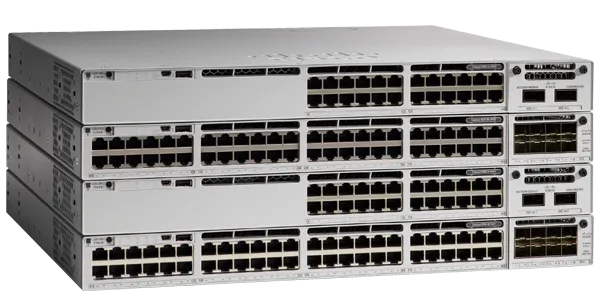
































Терез 88pl99ace1Cisco Catalyst 9300 series switches are a leading solution in enterprise networking, known for their high performance, flexibility, and scalability. One key feature of these switches is the console port, which provides network administrators with essential access for configuration, management, and troubleshooting of the switches. In this article, we will explore the specifics of the Cisco 9300console port, including its purpose, how to use it, and its key technical specifications.
The console port on the Cisco 9300 series switch is a dedicated interface that allows direct access to the device's command-line interface (CLI(1). This port is typically used for initial configuration and troubleshooting tasks. It bypasses the network to give administrators control over the switch, even if other network connectivity methods are unavailable.Using the console port, network engineers can configure switch settings, check system logs, reset configurations, and monitor the status of the switch. This local access is essential for managing switches, especially when remote access is not available or when initial setup is required.
Cisco 9300 switches come equipped with two types of console ports, giving users options depending on their connection preferences:
The RJ-45 console port is the traditional Ethernet-style port found on many networking devices. It connects to a computer's serial port via a rollover cable and a serial-to-USB adapter, if necessary. The default settings for accessing the RJ-45 console port are as follows:
Baud Rate: 9600 bps
Data Bits: 8
Stop Bits: 1
Parity: None
The USB Mini-B console port is a more modern interface available on Cisco 9300 switches. It allows for a quicker connection using a standard USB cable. Users often find the USB console port more convenient, as it eliminates the need for special adapters. Default access settings are similar to those for the RJ-45 port. Note: Only one console connection can be active at any given time. If both ports are connected, the USB connection takes priority.
To connect to the Cisco 9300 switch's console port, follow these steps:
Depending on the type of console port you plan to use, you will need:
RJ-45 Console Port: A rollover cable (RJ-45 to DB9) and a serial port on your computer or a serial-to-USB adapter.
USB Mini-B Console Port: A standard USB A to USB Mini-B cable.
Before connecting to the switch via the USB console port, you may need to install the Cisco USB driver, which is available on Cisco's official website. Once installed, your computer should recognize the USB connection as a serial COM port.
Using the appropriate cable, connect your computer to the console port on the Cisco 9300 switch.
Use terminal emulation software such as PuTTY, Tera Term, or HyperTerminal to establish a serial connection. Configure the terminal software with the default settings for the console port:
Baud Rate: 9600
Data Bits: 8
Stop Bits: 1
Parity: None
Flow Control: None
Once connected, press the "Enter" key to access the switch's command-line interface (CLI). You should now be able to configure the switch, monitor its status, or troubleshoot issues.
Below are some of the key technical specifications of the console ports available on the Cisco Catalyst 9300 switches:
RJ-45 Console Port: Provides serial access to the switch using a rollover cable.
USB Mini-B Console Port: Offers a direct connection using a USB cable, supporting faster and easier access.
Baud Rate: 9600 bps (default setting for both types of console ports).
Port Availability: Only one console port can be active at a time; USB takes precedence if both are connected.
Driver Requirement: USB console connections require a Cisco USB driver, available for download on Cisco’s website.
Terminal Software: PuTTY, Tera Term, or other terminal emulators are compatible with the console port.
Data Bits: 8 (default).
Stop Bits: 1 (default).
Parity: None.
Flow Control: None.
The Cisco 9300 console port offers several advantages for network administrators:
The console port allows administrators to configure and manage the switch without relying on the network. This is especially useful for initial setups, where network connections may not yet be available.
In situations where network connectivity is lost or misconfigurations occur, the console port provides a direct method of accessing the switch to resolve issues.
By offering both RJ-45 and USB Mini-B console ports, Cisco 9300 switches give users the flexibility to choose the most convenient connection method based on available equipment.
The console port requires physical access to the switch, making it a secure way to perform sensitive tasks such as configuration changes or software updates.
The Cisco 9300 console port is a critical tool in several networking scenarios. Some of the common use cases include:
During the first-time setup of the switch, administrators use the console port to input network settings and other configurations required for the switch to operate in the network.
When issues arise in the network, such as loss of connectivity or misconfigurations, the console port provides a direct connection to the switch, enabling quick troubleshooting and recovery.
The console port can be used to perform firmware updates or software upgrades on the Cisco 9300 switch, especially when the network is not fully operational.
In large networks, out-of-band management using the console port allows network administrators to manage switches without relying on the primary network, providing a more secure and resilient management solution.
The Cisco 9300 console port is an essential feature for network engineers, offering reliable and secure access to the switch's CLI for configuration, management, and troubleshooting. With both RJ-45 and USB Mini-B console options, Cisco provides the flexibility to connect in the most convenient way for the user. Understanding how to properly use the console port on a Cisco 9300 switch ensures that network administrators can efficiently manage their network infrastructure and maintain optimal network performance.
Cisco Catalyst 9300 Series Switches
For Cisco product list and quote, please visit: https://www.hi-network.com/categories/cisco or contact us at www.hi-network.com (Email: [email protected])
 Горячие метки:
CISCO коммутаторы CISCO
Горячие метки:
CISCO коммутаторы CISCO